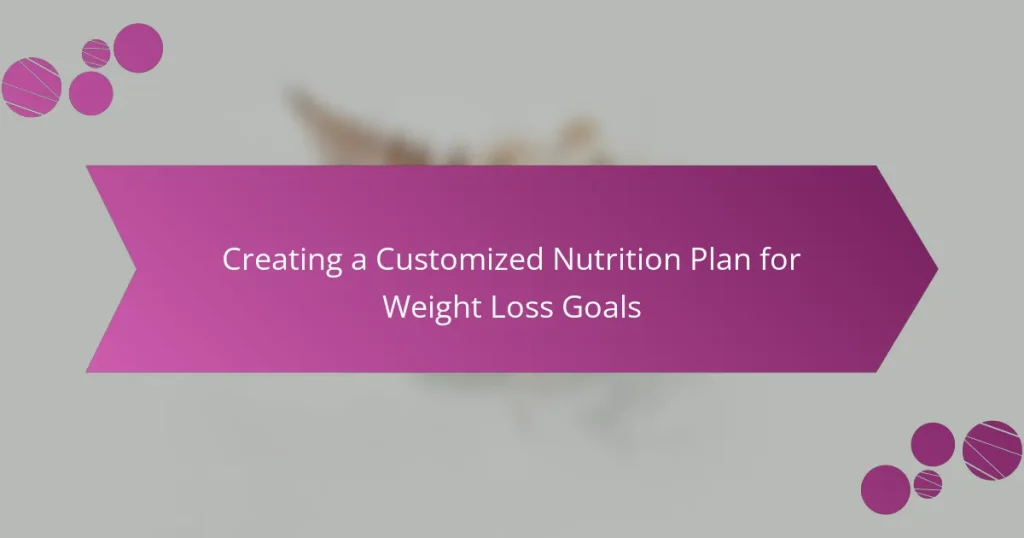Creating a customized nutrition plan for weight loss is essential for achieving your health goals effectively. By understanding your unique dietary needs and focusing on a balanced intake of macronutrients, you can enhance your chances of sustainable weight loss. This tailored approach not only promotes weight management but also supports overall health and well-being.

How to Create a Customized Nutrition Plan for Weight Loss?
Creating a customized nutrition plan for weight loss involves understanding your unique dietary needs, setting achievable goals, and ensuring a balanced intake of macronutrients. This tailored approach enhances the likelihood of sustainable weight loss and overall health improvement.
Assess individual dietary needs
Start by evaluating your current eating habits, lifestyle, and any specific dietary restrictions or preferences. Consider factors such as age, gender, activity level, and any medical conditions that may affect your nutritional requirements.
Utilize tools like food diaries or apps to track your daily intake and identify areas for improvement. Consulting with a registered dietitian can provide personalized insights and recommendations tailored to your needs.
Set realistic weight loss goals
Establishing realistic weight loss goals is crucial for maintaining motivation and achieving long-term success. Aim for a gradual weight loss of about 0.5 to 1 kg (1 to 2 pounds) per week, which is generally considered safe and sustainable.
Break down larger goals into smaller, manageable milestones. This approach not only makes the process less daunting but also allows for regular celebrations of progress, keeping you motivated along the way.
Incorporate balanced macronutrients
A balanced intake of macronutrients—carbohydrates, proteins, and fats—is essential for effective weight loss. Aim for a diet that includes approximately 45-65% carbohydrates, 20-35% fats, and 10-35% protein, adjusting these ranges based on your specific needs and preferences.
Focus on whole foods such as fruits, vegetables, lean proteins, whole grains, and healthy fats. This not only supports weight loss but also provides essential nutrients for overall health.
Utilize meal planning tools
Meal planning tools can simplify the process of creating a customized nutrition plan. Consider using apps or websites that offer meal prep ideas, grocery lists, and calorie tracking features to stay organized and on track.
Plan your meals for the week ahead, ensuring a variety of foods to prevent boredom and promote nutrient diversity. Preparing meals in advance can also help you resist the temptation of unhealthy options when you’re busy or tired.
Monitor progress regularly
Regularly monitoring your progress is key to staying accountable and making necessary adjustments to your nutrition plan. Track your weight, measurements, and how you feel physically and mentally throughout your journey.
Consider weekly or bi-weekly check-ins to assess your goals and make modifications if needed. This ongoing evaluation helps you stay focused and committed to your weight loss objectives, ensuring that your customized nutrition plan remains effective.

What Are the Key Components of a Nutrition Plan?
A well-structured nutrition plan for weight loss includes several essential components that work together to achieve your goals. Key elements include managing caloric intake and expenditure, balancing macronutrients, and maintaining proper hydration levels.
Caloric intake and expenditure
Caloric intake refers to the number of calories consumed through food and beverages, while caloric expenditure is the number of calories burned through daily activities and metabolic processes. To lose weight, you generally need to create a caloric deficit, meaning you consume fewer calories than you burn.
A common approach is to aim for a deficit of about 500 to 1000 calories per day, which can lead to a weight loss of approximately 0.5 to 1 kilogram per week. Tracking your daily caloric intake and expenditure can help you stay on target.
Macronutrient distribution
Macronutrients consist of carbohydrates, proteins, and fats, each playing a vital role in your nutrition plan. A balanced distribution of these macronutrients can support weight loss while ensuring you receive necessary nutrients.
A typical recommendation is to allocate around 45-65% of your daily calories to carbohydrates, 10-35% to protein, and 20-35% to fats. Adjusting these ratios based on personal preferences and dietary needs can optimize your results.
Hydration levels
Hydration is crucial for overall health and can significantly impact weight loss efforts. Proper hydration supports metabolism, aids digestion, and helps control hunger. Aim for at least 2 to 3 liters of water daily, adjusting based on activity level and climate.
Incorporating hydrating foods, such as fruits and vegetables, can also contribute to your daily fluid intake. Be mindful of sugary drinks, as they can add unnecessary calories and hinder your weight loss progress.

Which Foods Should Be Included in a Weight Loss Nutrition Plan?
A successful weight loss nutrition plan should focus on foods that promote satiety, provide essential nutrients, and support overall health. Prioritizing high-fiber foods, lean proteins, and healthy fats can help create a balanced diet that aids in weight management.
High-fiber foods
High-fiber foods are crucial for a weight loss nutrition plan as they help increase feelings of fullness and reduce overall calorie intake. Foods rich in fiber include fruits, vegetables, whole grains, and legumes. Aim for at least 25-30 grams of fiber per day to support digestion and weight loss.
Incorporating high-fiber foods can be simple. For instance, add beans to salads, choose whole grain bread over white bread, or snack on raw vegetables instead of chips. These choices not only enhance satiety but also provide vital vitamins and minerals.
Lean proteins
Lean proteins are essential for preserving muscle mass while losing weight. Sources such as chicken breast, turkey, fish, tofu, and legumes provide the necessary protein without excessive fat. Aim for protein to make up about 20-30% of your daily caloric intake to support metabolism and muscle repair.
Including lean proteins in meals can be straightforward. For example, grill chicken or fish for dinner, incorporate eggs into breakfast, or enjoy a protein-rich smoothie as a snack. These options help keep hunger at bay and support overall health.
Healthy fats
Healthy fats are important in a weight loss nutrition plan as they can enhance flavor and satisfaction, making meals more enjoyable. Sources like avocados, nuts, seeds, and olive oil provide essential fatty acids that support heart health. Aim for healthy fats to comprise about 20-35% of your total daily calories.
To incorporate healthy fats, consider adding a handful of nuts to your breakfast, drizzling olive oil on salads, or spreading avocado on whole grain toast. These small adjustments can significantly improve the nutritional quality of your meals while aiding in weight management.

How to Personalize a Nutrition Plan for Different Lifestyles?
To create a personalized nutrition plan for weight loss, consider individual lifestyle factors such as dietary restrictions, activity levels, and cultural preferences. Tailoring these elements ensures the plan is practical, sustainable, and effective for achieving weight loss goals.
Consider dietary restrictions
Dietary restrictions can stem from allergies, intolerances, or personal choices like vegetarianism or veganism. It’s crucial to identify these restrictions early to avoid foods that may cause adverse reactions or discomfort.
For example, if someone is lactose intolerant, incorporating dairy alternatives such as almond or oat milk can provide necessary nutrients without the negative effects. Always consult with a healthcare provider or nutritionist to ensure nutritional needs are met while adhering to restrictions.
Adapt to activity levels
Activity levels significantly influence caloric and nutritional needs. A sedentary individual will require fewer calories compared to someone who exercises regularly or engages in physically demanding work.
As a guideline, those with low activity may aim for around 1,600-2,000 calories per day, while active individuals might need 2,200-2,800 calories. Adjust macronutrient ratios accordingly, focusing on protein for muscle maintenance and carbohydrates for energy.
Factor in cultural preferences
Cultural preferences play a vital role in food choices and can impact adherence to a nutrition plan. Understanding and incorporating traditional foods can enhance enjoyment and sustainability of the diet.
For instance, if someone has a Mediterranean background, including olive oil, whole grains, and fresh vegetables can align with their cultural tastes while supporting weight loss. Encourage exploration of healthy versions of traditional dishes to maintain cultural identity while pursuing health goals.

What Tools Can Help in Creating a Nutrition Plan?
Several tools can assist in creating a customized nutrition plan for weight loss, focusing on tracking intake, meal planning, and professional guidance. Utilizing these resources can streamline the process and help ensure adherence to your goals.
MyFitnessPal for tracking
MyFitnessPal is a popular app that allows users to track their food intake and exercise. By logging meals and snacks, you can monitor your calorie consumption and nutritional balance, which is essential for weight loss. The app features a vast database of foods, making it easier to find and log items accurately.
To maximize its effectiveness, set specific daily calorie and macronutrient goals based on your weight loss objectives. Regularly reviewing your food diary can help identify patterns and areas for improvement, such as excessive snacking or high-calorie meals.
PlateJoy for meal planning
PlateJoy is a meal planning service that creates personalized meal plans based on your dietary preferences and goals. After answering a few questions about your eating habits and nutritional needs, PlateJoy generates a weekly menu and shopping list tailored to your weight loss plan.
This tool can save time and reduce the stress of deciding what to eat daily. Consider using PlateJoy to explore new recipes and ensure you are consuming a balanced diet, which is crucial for sustainable weight loss.
Nutritionist consultations
Consulting with a nutritionist can provide personalized insights and strategies for your weight loss journey. A qualified nutritionist can assess your dietary habits, health status, and lifestyle to create a tailored nutrition plan that aligns with your goals.
When seeking a nutritionist, look for someone with relevant credentials and experience in weight management. Regular sessions can help keep you accountable and allow for adjustments to your plan as needed, ensuring you stay on track with your weight loss objectives.

